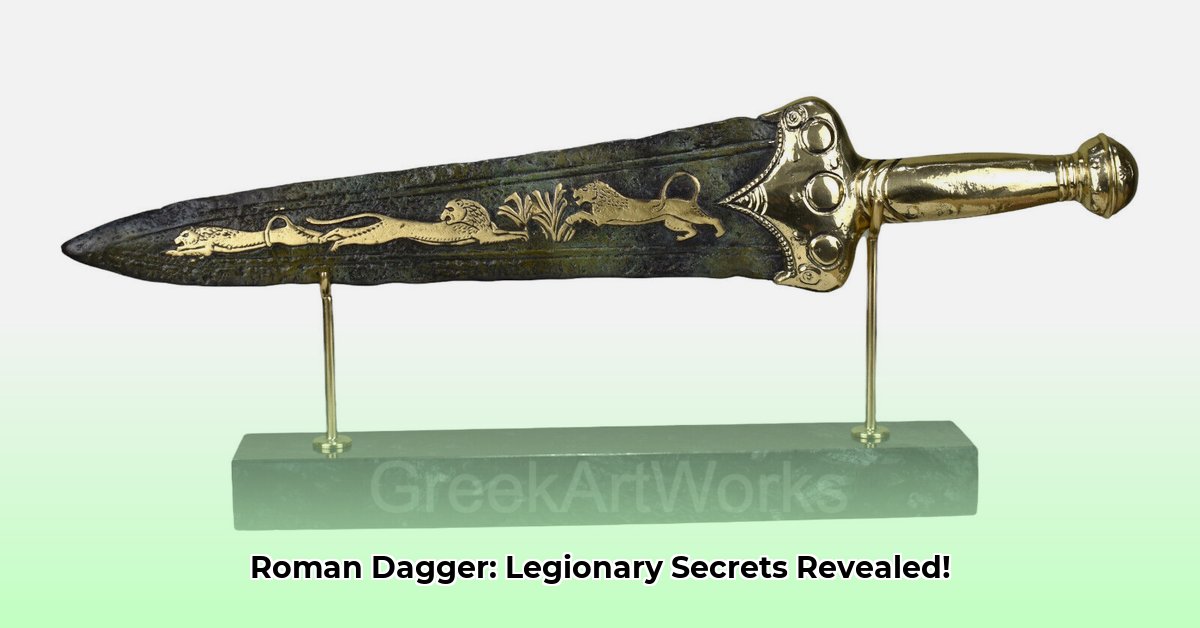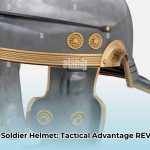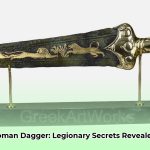Ever wondered about the formidable yet often overlooked dagger carried by Roman soldiers? The pugio (plural: pugiones) was far more than a mere sidearm; it stood as a critical component of Roman military equipment and a potent symbol of legionary identity and readiness. This comprehensive article delves into every facet of this versatile weapon, tracing its origins and intricate design to its crucial battlefield applications and profound symbolic significance. We will explore how modern researchers meticulously study its archaeological artifacts, how historical reenactors can achieve unparalleled accuracy in their replicas, and how museum curators can craft immersive and educational historical displays. Whether your interest lies in ancient military history, detailed historical reconstruction, or engaging curatorial practices, this guide offers an in-depth understanding of the Roman pugio.
Key Takeaways:
- The pugio was a versatile Roman military sidearm, evolving from Iberian designs to become exceptionally effective in close-quarters combat (CQC).
- Beyond its tactical utility, the pugio held significant symbolic value, representing a legionary’s status, personal identity, and unwavering commitment to military service through its design and personalization.
- Its detailed study offers actionable insights for researchers (artifact analysis), reenactors (accurate replication), and curators (engaging historical displays), bridging the gap between historical fact and modern application.
The Pugio: More Than Just a Blade
The compelling story of the Roman pugio—a compact, often leaf-shaped dagger—does not originate in Rome itself. Its history is deeply intertwined with the daggers utilized by the Cantabrians, skilled warriors from the Iberian Peninsula (modern-day Spain). The pragmatic Romans, ever keen to adopt and adapt effective technologies from their adversaries, recognized the profound utility of this design during their fierce conflicts with Celtiberian tribes. They swiftly integrated and refined it for their own disciplined legions. This pivotal adoption raises an intriguing question: How did a seemingly simple Iberian blade evolve into such an iconic and indispensable piece of Roman legionary equipment? This ongoing inquiry continues to drive much of contemporary archaeological and historical research. Like the Roman soldier helmet, the pugio was a crucial piece of equipment.
The very word “pugio” offers a clue to its primary function, deriving directly from the Latin verb pungo, meaning “to stab” or “to pierce.” Its root, pug, is also found in pugnus (meaning “fist”) and pugna (meaning “a fight” or “an exchange of thrusts”), highlighting the weapon’s direct, close-contact nature, akin to a punch or a forceful thrust delivered by the fist. This etymological connection underscores the Roman preference for direct, decisive combat.
Design and Construction: A Closer Look
The typical ancient Roman dagger featured a robust, double-edged blade primarily engineered for stabbing, meticulously optimized for thrusting and piercing attacks. Historians continue to debate whether iron or bronze was the predominant material for these blades, although archaeological evidence consistently reveals sophisticated Roman metalworking techniques. Blades varied in form: some exhibited the distinct “leaf-shaped” profile, while others featured narrow, parallel sections near the shoulders before tapering sharply to a point. Many designs incorporated a pronounced midrib running along each side, either standing out or defined by deep grooves. Blade lengths commonly ranged from 18 to 28 centimeters (approximately 7.1 to 11.0 inches) long, with widths often exceeding 5 centimeters (2.0 inches).
The hilt of the pugio was meticulously crafted for a secure grip, typically measuring 10 to 13 centimeters (3.9 to 5.1 inches) in length. It was commonly constructed from two layers of organic material—such as horn, wood, or bone—sandwiching the blade’s tang. These layers were then often overlaid with thin iron plates, which could be solid or embossed into a roughly trapezoidal pommel shape. Decoratively, silver inlay frequently adorned the hilt, signifying status or personal pride. While the grip was generally narrow, a well-engineered expansion in the center provided an exceptionally secure hold, even during intense combat. Early designs featured a tang riveted directly through the grip, though by the early 1st century AD, rod tangs became prevalent, with the hilt secured primarily at the blade’s shoulders. Archaeological findings indicate that these rod tangs could be less secure, leading to instances of replacement handles, some even repurposed from sword grips.
The accompanying sheath was equally as significant as the blade itself, often becoming a canvas for intricate artwork. Far from being simple protective covers, pugio sheaths were frequently adorned with elaborate decorations, showcasing the exceptional craftsmanship of the era. Materials varied widely, ranging from basic wood and leather to more elaborate options such as iron, bronze, and vibrant enamel. These variations often indicated a soldier’s rank, affiliation with a specific legion, or simply personal preference and wealth.
By the second quarter of the 1st century AD, three main sheath types were in widespread use, each reflecting evolving design preferences and manufacturing capabilities:
| Sheath Type | Primary Construction | Common Decoration & Features |
|---|---|---|
| Type A | Made with curving metal plates (usually iron) at both the front and back, encasing a wooden lining. | The front plate was typically heavily decorated with meticulously inlaid brass, silver, niello, and vibrant red, yellow, or green enamel. Featured round, free-running suspension rings attached by bifurcated, riveted mountings. Modern reconstructions using applied brass plates with visible rivets are historically inaccurate based on archaeological evidence. |
| Type B | Primarily a wooden sheath, often covered with leather. A single, relatively flat metal plate (almost always iron) was attached to the front. | Heavily decorated with inlaid silver (or occasionally tin) and enamel. The suspension rings resembled small Roman military buckles and were ingeniously hinged to the sides of the sheath, allowing for fluid movement. |
| Frame Type | Constructed from iron, consisting of a pair of curved channels that converged at the lower end, typically worked into a flattened, round terminal expansion. These channels were joined by two horizontal bands at the top and middle, which also retained the suspension rings. These sheaths would have encased a now-lost wooden core. An example from Titelberg shows channels inserted into a bulbous terminal formed with a ferrule, secured by a decorated rivet. | While less ornate than Types A and B, the Frame Type often featured an elegantly formed, flattened round terminal, and examples like the one from Titelberg demonstrate decorative rivets. The overall design was robust and functional, with the exposed iron channels forming part of its aesthetic. |
All three types shared common features, including four suspension rings (though evidence suggests the two lower rings were often unused) and a bulbous terminal expansion pierced by a large rivet. These subtle distinctions offer rich insights into the Roman economy, available resources, and their extensive trade networks.
Tactical Advantage: The Pugio in Roman Combat
The pugio was far from a mere decorative accessory; it functioned as an indispensable tool within the highly disciplined Roman military machine. Given its compact design, how was the pugio effectively deployed in the unforgiving crucible of battle? Its relatively small size and double-edged blade allowed legionaries to deliver swift, efficient thrusts to enemies at extremely close range, proving invaluable when the larger gladius (short sword) was impractical or lost. Vegetius, a late Roman writer on military matters, famously underscored the Roman preference for stabbing: “A stroke with the edges, though made with ever so much force, seldom kills… On the contrary, a stab, though it penetrates but two inches, is generally fatal.” This emphasizes the pugio‘s design as a highly effective thrusting weapon, capable of inflicting deadly wounds with precision.
While its primary role was evidently close-quarters combat, the pugio also served as a versatile utility knife for a Roman soldier’s daily life. A legionary might have regularly used it for mundane yet essential chores around camp, such as cutting rope for rigging tents, preparing hardtack and other food rations, or performing basic equipment repairs. It could also have been employed for digging, prying, or even as a simple tool for crafting and maintenance. This multifaceted utility reinforces the notion that the pugio was an everyday companion, relied upon for both protection and practical tasks. Furthermore, the pugio was known to be carried by various members of the Roman military, including auxiliaries and cavalry troops, and even some gladiators in the arena, showcasing its broad adoption across diverse martial contexts. Its smaller size also made it an ideal weapon for finishing off wounded enemies or for more discreet personal defense.
Preserving History: Research, Reenactment, and Display
Understanding the pugio extends far beyond historical texts; it involves dynamic, hands-on engagement through meticulous research, authentic reconstruction, and compelling public dissemination.
For Researchers: Unlocking Ancient Secrets
Analyzing pugio artifacts unearthed from Roman archaeological sites is paramount for uncovering ancient secrets and piecing together the daily lives of Roman soldiers. Scholars meticulously map regional variations in design, precisely identify the specific materials used (from rare metals to organic components), and rigorously study wear patterns to infer usage and maintenance. Advanced scientific techniques, such as metallographic analysis and X-ray fluorescence, are employed to reveal sophisticated Roman metalworking techniques and the composition of alloys.
Furthermore, experts utilize cutting-edge computer modeling and forensic archaeology to simulate Roman combat scenarios. These simulations focus on factors like armor types, the dynamics of troop formations, and optimal weapon handling. These sophisticated models provide invaluable insights into how the pugio functioned in actual combat situations, enhancing our knowledge of Roman military strategy and the lethality of ancient weaponry. The discovery of a pugio from Titelberg, for instance, offered crucial insights into the precise construction of the “frame type” sheath, allowing researchers to accurately reconstruct its assembly.
For Reenactors: Stepping Back in Time
For those dedicated to achieving uncompromised historical accuracy in their portrayals, replicating pugio sheaths and the dagger itself demands rigorous attention to every minute detail. This involves sourcing and utilizing historically correct materials, such as specific types of wood for the core, appropriate grades of iron or bronze for blades and fittings, and authentic pigments for enamelwork. It is equally crucial to employ period-appropriate construction methods, carefully avoiding common reconstruction errors, especially concerning riveting techniques and the exact form of suspension rings. The “common mistake” of applied brass plates attached by rivets, for example, must be avoided as no such archaeological evidence supports it.
Collaborating closely with professional historians and archaeologists can significantly enhance the authenticity of reenactments. Enthusiasts should delve into specific historical details, encompassing not only the appearance of the pugio but also legionary drills and combat maneuvers, the deployment and role of auxiliary units, and even how Roman civilians might have wielded a dagger for personal defense or daily utility. These nuanced details imbue reenactments with greater depth and authenticity, providing a more immersive and educational experience for both participants and observers.
Steps for Replicating Pugio Sheaths Accurately:
- Thorough Research of Historical Designs: Meticulously investigate authentic pugio sheath typologies (e.g., Type A, Type B, Frame Type) documented in archaeological reports, paying close attention to dimensions, material composition, and decorative motifs.
- Acquisition of Authentic Materials: Source materials that closely match historical findings, including specific varieties of wood for the core, appropriate grades of leather for covering, and historically accurate metals (iron, bronze, silver, tin) for decorative plates, inlays, and structural components.
- Mastery of Traditional Crafting Techniques: Learn and apply historical methods for cutting, shaping, joining, and decorating the sheath components. This includes precise metalworking techniques for inlay and embossing, and correct riveting methods for structural integrity, avoiding anachronistic shortcuts.
- Meticulous Attention to Fine Details: Focus intently on the precise size and placement of rivets, the exact form of suspension rings (e.g., small Roman military buckles or simple round rings), and the intricate patterns of decorative inlays, ensuring they faithfully reproduce archaeological findings.
- Consultation with Experts: Regularly seek guidance and peer review from professional historians, archaeologists specializing in Roman military equipment, and highly experienced historical reenactors to validate methods, materials, and overall accuracy.
- Functionality Testing and Wearability: Ensure the replicated sheath not only appears historically accurate but also correctly accommodates the pugio blade and can be comfortably and securely worn as an integral part of a legionary’s complete kit, reflecting practical historical use.
For Curators: Engaging the Public
Museum displays offer an unparalleled opportunity to educate and inspire the public about the fascinating world of ancient Rome. Exhibits should thoughtfully present the ancient Roman dagger’s profound tactical significance, its deep symbolic importance, and the unique personal touches often applied by individual soldiers. Interactive exhibits can powerfully allow visitors to explore the pugio’s intricate design evolution over centuries and its profound impact on the Roman army’s overall effectiveness. Museums can further enhance visitor engagement through the strategic use of touchable replicas, allowing for tactile learning, and compelling virtual reality experiences, providing an immersive journey into Roman military life and the pugio‘s role within it. Incorporating high-resolution digital scans of actual artifacts can offer an unparalleled level of detail.
| Advantage | Challenge |
|---|---|
| Creates highly engaging and informative exhibits for diverse audiences | Requires significant interdisciplinary research and substantial financial resources |
| Provides a deeper, multi-faceted understanding of Roman military history | Needs careful planning and expert consultation to ensure absolute historical accuracy and avoid misrepresentation |
| Attracts a wider demographic to the museum, including niche enthusiasts | May be challenging to create truly interactive and educational elements that resonate across all age groups and knowledge levels |
Symbolic Status: Personal Expression and Legacy
Beyond its undeniable practical applications, the ancient Roman dagger carried substantial symbolic weight within Roman society and the military. It could profoundly signify a soldier’s elevated status, their unwavering loyalty and pride in a specific legion, and even elements of their personal style and identity. Roman soldiers frequently personalized their weapons, often at considerable personal expense. How did they infuse such individuality into an item that was, at its core, a standardized piece of military equipment? Many experts believe that the intricate decorations found on sheaths, from detailed metal inlays to vibrant enamelwork, served as a powerful non-verbal means for soldiers to express their unique identity, their personal achievements, and their profound pride in military service. The “pear shaped” hilt, mentioned in some sources, was specifically designed to fit snugly in the hand, further emphasizing a personal connection to the weapon.
The pugio‘s chilling, indelible role in pivotal historical events, most notably the infamous assassination of Julius Caesar on the Ides of March in 44 BC, starkly illustrates its dual nature: not only a potentially concealed weapon but also a potent symbol of political power, betrayal, and inexorable fate. Caesar was reportedly stabbed 23 times, with many of those wounds inflicted by pugiones wielded by the conspirators. The decision by senators to use these daggers was undoubtedly made for practical reasons: their compact size allowed for easy concealment beneath a toga, unlike a larger gladius. The shorter blade also enabled conspirators to inflict quicker and more numerous thrusts in a short period, crucial















